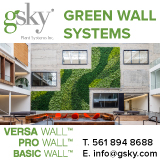

Pages: 1
| Posted: 17 Mar 2011 22:11 | |
|
Registered User Currently Offline Join Date: Mar 2011 |
Posts: 1 Reputation: Unranked User Rank: 1 - Seedling 
|
| Does anyone have a sample of an estimate formula sheet, or can someone help me as to what are all the factors I must consider and how they play into the estimate. I am trying to figure out an estimate formaula to do interiorscape lease and maintenance. | |
| Posted: 19 Mar 2011 15:14 | |
|
Registered User Currently Offline Join Date: Jan 2011 |
Posts: 798 Reputation: 43 User Rank: 10 - Blossom 
|
|
There is no boilerplate "estimate formula sheet" in our industry that will work for every company. However, there are a few factors you need to account for when bidding and estimating jobs:
1. True costs for all items incorporated in the quotation: plants, containers, accessories, shipping costs, delivery and installation labor and vehicle costs, cost of capital required to cover all of the above, insurance costs, your facility costs, etc. 2. Length of lease agreement/minimum non-cancellable term of lease/desired payback timeframe of leased items 3. Expected costs of replacement plants based on prior experience with similar accounts 4. Labor costs for the maintenance phase The best way to manage this is to either purchase a turn-key software package designed for the interiorscape industry or to create some simple spreadsheets that will help you calculate these items accurately. If you're good at Excel or a database program, great. If not, hire someone who is to help you design some tools, or look into the various vendors for software to see whether that would be a better option to get you up and running. Clem |
|
| Posted: 26 Jun 2011 04:29 | |
|
Registered User Currently Offline Join Date: Feb 2011 |
Posts: 13 Reputation: Unranked User Rank: 1 - Seedling 
|
|
Could someone please grade me on my first attempt to make an estimate on a recurring service?
1. Fixed Costs Licenses & Permits = $18 Fuel = $40 Insurance = $35 Phone = 10 Ofc Supply = 20 Total Fixed Costs = 123 3. Plant Replacements (plants valued at $4150 + $1245(shipping)= $5395) Shipping = $34 (to replace plants every 3 yrs) Plants = $116 (to replace plants every 3 yrs) Supplies = $20 Total Variable Costs = $170 4. Labor Costs for Maintenance Technician = $444 ($20.5/hr at 5hrs/wk) Ofc work = $444 ($20.5/hr at 5 hrs/wk) Total Labor Costs = $888 ___________________________________________________ Total Monthly Service Charge = $1181 This really is my first attempt so please go easy on me. Thanks! |
|
| Posted: 26 Jun 2011 13:22 | |
|
Registered User Currently Offline Join Date: Jan 2011 |
Posts: 106 Reputation: 4 User Rank: 3 - Plant 
|
| how many plants do you have? is the labor rate the rate you are paying the tech or the rate you are charging the client? if latter, it's WAY too low | |
| Posted: 26 Jun 2011 19:36 | |
|
Registered User Currently Offline Join Date: Feb 2011 |
Posts: 13 Reputation: Unranked User Rank: 1 - Seedling 
|
|
#Plants= 315 (6"=249, 8"=6, 10"=39, 14+"=15, Bloom=6)
Labor Rate= Both: Paying the tech and charging the client. I will be the tech for the 1st year, then will hire an employee and pay $12-$14/hr. Is it reasonable to assume 1hr of office work per 1hr of maintenance work? Is it more reasonable to charge the client a labor rate of $40/ hour, including the office work, but assume the office work will be less? Is there an industry average Labor Rate? I happen to know their current vendor is charging, $1111, but has never raised their rates and is not providing a satisfactory service. Your help is invaluable! |
|
| Posted: 26 Jun 2011 21:27 | |
|
Registered User Currently Offline Join Date: Jan 2011 |
Posts: 106 Reputation: 4 User Rank: 3 - Plant 
|
|
discussing a specific labor rate would be inappropriate if not illegal, but your first rate was way low and your second rate is probably more in line with norms. we charge more than that, but are in a large market and svc a specialized niche.
that's a lot of plannts to svc weekly. is the current vendor servicing weekly also? are thos 6" plants in individual planters or multiples or in planter beds? |
|
| Posted: 26 Jun 2011 23:09 | |
|
Registered User Currently Offline Join Date: Feb 2011 |
Posts: 13 Reputation: Unranked User Rank: 1 - Seedling 
|
|
Thanks Alex,
Most 6" plants are in multiples of 2 in "topsiders", but some are individuals. Current vendor is servicing weekly at 5 hours/wk. It never occurred to me it would be illegal to discuss a labor rate. I appreciate you informing me, but what is the reasoning? There are alot of statistics out their on average salarys and pay rates for other fields of work, but for some reason, this one has been difficult to obtain information on- been working on this for 9 months now! Very much appreciate your help! |
|
| Posted: 27 Jun 2011 16:33 | |
|
Registered User Currently Offline Join Date: Jan 2011 |
Posts: 102 Reputation: 5 User Rank: 3 - Plant 
|
|
Am I correct in assuming that you have no facility? Or never plan to have one? As best as I can tell, you have no money in there for it.
What about the cost of the vehicle? All you have is fuel and (maybe) licenses. Was it free? These are some of the indirect costs that many people forget. Initially, on start-up of a business, that is how many people get in the door...they absorb the cost. If you want to grow, thinking long-term is important from the beginning. Julie |
|
| Posted: 27 Jun 2011 19:28 | |
|
Registered User Currently Offline Join Date: Jan 2011 |
Posts: 798 Reputation: 43 User Rank: 10 - Blossom 
|
| Costs (TRUE costs, all-inclusive!) + Markup = Selling Price | |
| Posted: 27 Jun 2011 23:38 | |
|
Registered User Currently Offline Join Date: Jan 2011 |
Posts: 102 Reputation: 5 User Rank: 3 - Plant 
|
|
Using our company's formula, I am coming out with a little over 3.75 hours for basic maintenance (water, trim, dust/clean). That does not include time for ladderwork, travel time to the account, labor to do replacements/changeouts, spraying time, and walking time (if higher than normal). That many 6" can distort our formula, so then we use the "common sense" factor. 6" plants usually distort the time on the high side, in which case, the time should be even less. Five hours still seems high to me.
We arrived at our maintenance times by doing time studies of our average technician. We had them do the maintenance on each size of plant being analyzed and literally timed them from start to finish. Some people just use the blanket rate of 2 minutes (or 3?) per plant. I'm not quite sure what your method was. Clearly, light levels impact plant replacements. It looks like you are using 10% per year for the replacement level. That is not bad, if the light levels are good. An Aglaonema in 40 f.c. will turn over at a higher rate than that, unless you compromise your quality standards, which it sounds like you are not willing to do (yay!). You can use the 10% as a broad stroke, but I'd recommend literally assigning a life span to each. Once you gain a history, you will be able to tweak just how accurate those predictions were. You've got to start somewhere, I guess! At least you are trying to do it logically. I can appreciate that! Keep at it. Julie |
|
| Posted: 28 Jun 2011 00:21 | |
|
Registered User Currently Offline Join Date: Feb 2011 |
Posts: 13 Reputation: Unranked User Rank: 1 - Seedling 
|
|
Thanks Julie and Clem!
Julie, Facility: Correct, I will have no facility. Vehicle: Using personal vehicle. Waiting for an Insurance quote on commercial use of my vehicle, and will add that in as a fixed cost. To be honest, I assumed that is the only cost I could factor in. I was even thinking I couldn't factor in fuel, since I will just be driving from my home to the account. Will only have this one account to get started, so no fuel costs in between accounts. Formula: That's awesome you actually came up w/ a formula based on the # of plants. I"ll try to come up w/ my own. Thanks for sharing it w/ me. 6" plants require a ladder to service. Account has 3 separate buildings, close by, but require loading and unloading equipment, and minimal driving (less than 1/4 of a mile). Maybe the time is actually less though. Replacement Level: Instead of selecting 10%, decided on a goal of having to replace plants every 3 years, to keep it fresh and rotating, but knowing some would be much longer, and some shorter. I like how specific your strategy is though- giving each particular plant a lifespan. Thanks for the tip! Clem, Thanks for the formula! I suspect once I get my feet wet, the true costs will become more clear. Still not sure how much office time to factor in. It's the variable costs- which can be so variable, which makes this equation difficult! And the Markup- Is it legal for me to ask if there is an Industry Average? 30% cost-plus? Exceptionally greatfull to all of you! |
|
| Posted: 28 Jun 2011 01:54 | |
|
Registered User Currently Offline Join Date: Jan 2011 |
Posts: 106 Reputation: 4 User Rank: 3 - Plant 
|
| establish your pricing from the beginning as if you had a REAL company with all the expenses that go with that. that is the only way you will survive and prosper. | |
| Posted: 28 Jun 2011 15:48 | |
|
Registered User Currently Offline Join Date: Jan 2011 |
Posts: 102 Reputation: 5 User Rank: 3 - Plant 
|
|
Facility: I know that you have none, but how will you ever get one if you don't factor it in? It's just like planned savings. You put aside a certain amount of every dollar that comes in towards the future, unless the only way that you can break into the industry is by "eating" those costs until you can't anymore.
Vehicle: Yes, you absolutely should factor in your travel time from home to the account. That is the cost of business to get there. That is not a "freebie". That's why you want to try to get multiple accounts in one area... to spread out the costs. Remember, there are "fixed" costs with vehicles, such as oil changes, tires, etc. too. If not included initially, as your vehicle is used more and more for service, that should become part of the bid as a standard cost. Perhaps the government allowance for IRS purposes should be your starting point if you can't nail down specifics yet. Plants: Some people use your cost in the bid formula, some people build it in as the retail cost. Formula: You are correct. Using ladders to access planters and multiple buildings will extend your maintenance time. For 6 ft. ladders, we can add as much as 5 minutes per ladder location. Sometimes we can reach multiple plants from one ladder location. Profit: Is there any in this formula? Are you assuming that you are making it on the labor bid portion? More food for thought. Julie |
|
| Posted: 28 Jun 2011 23:33 Last Edited By: Clem | |
|
Registered User Currently Offline Join Date: Jan 2011 |
Posts: 798 Reputation: 43 User Rank: 10 - Blossom 
|
|
In prehistoric times, the CW (Conventional Wisdom) was to double the cost of plants to arrive at a selling price, and multiply the cost of containers by 1.5 to get their selling price. These days, you may need to be a bit leaner than that to win bids. That's why establishing YOUR OWN pricing and fee schedules for labor and materials as well as plants and containers is so important...win jobs at YOUR price. That may mean not getting involved in competitive bidding, instead targeting small office and residential accounts that don't attract big competitors in your market. You can have a virtual monopoly on those if you do great work and specialize in the care and feeding of those unique clients.
10% replacement rate per year (that's 10% of the INSTALLED COST of the plant inventory) is a good goal, but as Julie said, it's a goal and not a fixed number. In your first few years in business, you may find your replacement rates will vary wildly from account to account, or that replacements of plants from some suppliers will run higher than others due to quality, shade acclimatization, etc. Figure a bit higher, maybe 15% or so, and if you do better, adjust your formula going forward and reward yourself by pocketing the "bonus" money you saved by being better than your target of 15% (we hope). That's Barb Helfman's TOPTactics philosophy, on which I was weaned. Props to Barb as always! Don't forget that part about TRUE COSTS...things like travel time on routes, vehicle costs (all of them), insurance (all kinds), office expenses, etc. all figure into the calculations. Without knowing those costs, how can you know whether you'll be profitable at some point in time? Clem |
|
| Posted: 29 Jun 2011 22:16 | |
|
Registered User Currently Offline Join Date: Feb 2011 |
Posts: 13 Reputation: Unranked User Rank: 1 - Seedling 
|
|
You guys are the best! Thankyou so much for your help!
Alex, Great approach! It has made me think 2x about how I am doing this. Julie, Facility: I am assuming this won't be necessary- but I like the idea of giving it a category in my Fixed Costs and leaving it as an option. Vehicle: Eye-opener! Thankyou. I didn't know I could factor this in, since the title is not in the name of the business. Will use the IRS allowance and will talk to an accountant at SCORE tomarrow to get more clear on this. Profit: Yes, was assuming I was making it on the labor bid portion. This is the part of the equation I am so confused on. Not sure what is standard for the industry. Clem, Pricing: Thanks for the historical strategy on this. It gives me something to work with. Replacement Rate: I like the 15% safety net. I think it is also very respectful to have this in place for the employees I will eventually hire. Let them learn and make their mistakes. Thankyou for throwing out this # because I wasn't sure if it was acceptable. TRUE COSTS: I think my mind is in the process of switching over from hourly employment- which I have always done, to salaried. So I am still getting comfortable with factoring in thinks like driving time. Thanks so much for the permission! __________________________________ Thanks everyone! I"ll work on some more details for awhile, getting help from local resources, then come back here. |
|
| Posted: 29 Jun 2011 22:51 | |
|
Registered User Currently Offline Join Date: Jan 2011 |
Posts: 102 Reputation: 5 User Rank: 3 - Plant 
|
|
I don't have the greatest patience for people who want all of the information handed to them without any work, but clearly you are willing to do some "due diligence" to get an accurate price. Good efforts! The key is to truly think about all relevant aspects, not just the direct costs.
Julie |
|
| Posted: 30 Jun 2011 04:04 | |
|
Registered User Currently Offline Join Date: Jan 2011 |
Posts: 798 Reputation: 43 User Rank: 10 - Blossom 
|
|
One of the best things you can do for your own sanity since you're going to be salesperson, tech, installer, manager and all rolled into one is to develop a few simple spreadsheets to automate your paperwork and speed your turnaround time on quotations.
I made one for straight purchase quotations and adapted it for lease quotations. It assigns a maintenance figure for each plant based on pot size, plant cost and relative maintenance intensity so it simultaneously figures the plant and container pricing as well as maintenance charges and lease rates. Excel will be a useful tool (or the free equivalent in Open Office, available as a free download online) for making forms as well as calculating things like quotations and keeping track of replacement costs by account to help you with your SECOND year renewal pricing. One day you may be flush with cash and ready to purchase a turnkey software suite that will take you from quotation to sales order to installation pull list to inventory roster to monthly invoicing, but until then you can do pretty well with ordinary computer tools like Excel and Word. Clem |
|
| Posted: 10 Aug 2011 17:38 | |
|
Registered User Currently Offline Join Date: Aug 2011 |
Posts: 6 Reputation: Unranked User Rank: 1 - Seedling 
|
| Just something I noticed. A customer is not a government agency. You have to justify everything when reporting expenses to the IRS, e.g. ownership of the car, but there's no need to do that for a customer and it's more information than a customer will want to worry about anyway. All they'll care about is 1) is your work good, and 2) is the price reasonable? And they'll judge both by comparison to your competitors not by reference to anything internal to your operation. You need to know all these gory details in order to set your price well, but your customer doesn't need to know it except when it comes to things like the price of a new plant. | |
| Posted: 10 Aug 2011 17:47 | |
|
Registered User Currently Offline Join Date: Jan 2011 |
Posts: 798 Reputation: 43 User Rank: 10 - Blossom 
|
|
I don't think the thrust of the discussion was how to justify your pricing to your clients, but rather how to calculate your pricing based on your own TRUE COSTS and automate the process from pencil-and-paper to computer. We don't share with our clients the method we use to figure our rates and selling prices nor how much we markup from costs. That's none of their business; the bottom line price we charge them is.
Clem |
|
Pages: 1
Interiorscape.com is sponsored by NewPro Containers ![]() RSS 2.0
RSS 2.0 ![]() Atom 1.0
Atom 1.0













